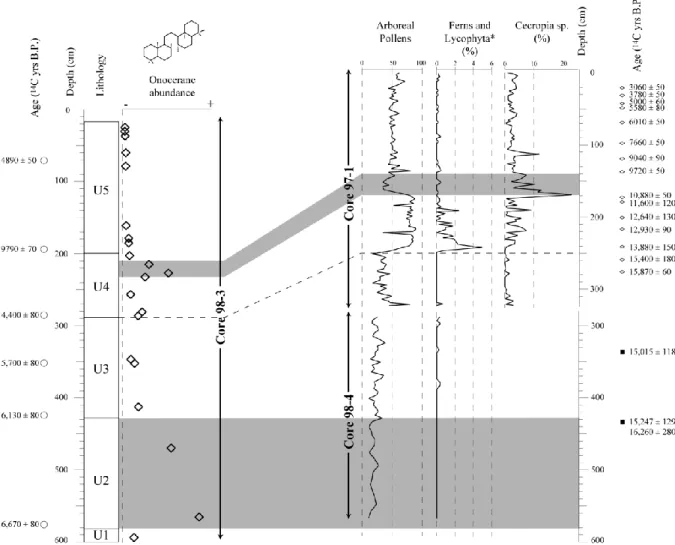HAL Id: hal-00022465
https://hal-insu.archives-ouvertes.fr/hal-00022465
Submitted on 12 Apr 2006HAL is a multi-disciplinary open access
archive for the deposit and dissemination of sci-entific research documents, whether they are pub-lished or not. The documents may come from teaching and research institutions in France or abroad, or from public or private research centers.
L’archive ouverte pluridisciplinaire HAL, est destinée au dépôt et à la diffusion de documents scientifiques de niveau recherche, publiés ou non, émanant des établissements d’enseignement et de recherche français ou étrangers, des laboratoires publics ou privés.
Onocerane I witnesses to dry climatic phases at the end
of Last Glacial Maximum and during the Younger Dryas
in Northern Brazil.
Jérémy Jacob, Jean-Robert Disnar, Mohammed Boussafir, Marie-Pierre
Ledru, Abdelfettah Sifeddine, Ana Luiza Spadano Albuquerque, Bruno Turcq
To cite this version:
Jérémy Jacob, Jean-Robert Disnar, Mohammed Boussafir, Marie-Pierre Ledru, Abdelfettah Sifeddine, et al.. Onocerane I witnesses to dry climatic phases at the end of Last Glacial Maximum and during the Younger Dryas in Northern Brazil.. 21st International Meeting on Organic Geochemistry, 2003, Kralow, Poland. �hal-00022465�
ONOCERANE I WITNESSES TO DRY CLIMATIC PHASES
AT THE END OF LAST GLACIAL MAXIMUM AND DURING THE YOUNGER DRYAS IN NORTHERN BRAZIL
Jérémy JACOB1, Jean-Robert DISNAR1, Mohammed BOUSSAFIR1, Marie-Pierre LEDRU2, Abdelfettah SIFEDDINE3, Ana Luiza Spadano ALBUQUERQUE3 and Bruno TURCQ4. 1
Laboratoire de Sédimentation et Diagenèse de la Matière Organique, Institut des Sciences de la Terre d’Orléans (ISTO) - UMR 6113 du CNRS, Université d'Orléans, Bâtiment Géosciences, 45067 Orléans Cédex 2, France.
2
IRD/CNPq, Universidade de Sao Paulo, Departamento Geologia Sedimentar e Ambiental, rua do Lago 562, 05508-900, Sao Paulo, Sao Paulo, Brazil.
3
Departamento de Geoquimica, Universidade Federal Fluminense, Morro do Valonguinho s/no. 24020-007 Niteroi, Rio de Janeiro, Brazil.
4
UR055, IRD, Centre d’Ile de France, Institut de Recherche pour le Développement, 32 av. Henri Varagnat. 93143, Bondy Cedex, France.
O.
Onocerane-related compounds are very uncommon molecules that are seldom encountered in the plant kingdom and even more rarely in sediments. In living plants, onoceranoids have been isolated from taxa as diverse as ferns, club mosses and Fabaceae. In this latter, onocerin (onoceranediol) is supposed to render the roots water-impermeable and to allow the plants belonging to this genus to colonize water-depleted media. In sediments, onoceranes have been observed up to the Carboniferous but mainly in post-Cretaceous series always deposited in continental settings (lacustrine, intramontane basins, lagoonal or brackish contexts).
We here report on the first occurrence of onocerane I in Late Pleistocene and Quaternary sediments, collected in a lake located almost under the Equator (Lagoa do Caço, NE Brazil). The comparison of onocerane I abundance with palynological results all through the last 20,000 years allow us to exclude ferns and club mosses as possible producers of onocerane in this setting. Onocerane I is only found in significant amounts in two distinct sedimentary intervals: the first, rapidly deposited at the end of Last Glacial Maximum (c.a. 21,000 cal yrs B.P.) and the second during the Younger Dryas (between 13,000 and 12,000 cal yrs B.P.) (figure 1). These two periods are both documented as having been dryer than those prevailing presently. Therefore, the presence of onocerane I in the sediments deposited during these two intervals testimonies to the development of plants adapted to water-deficient environments. No evidence of a possible precursor can be deciphered from palynological results, probably due to the poor conservation of the pollen of these plants.
Figure 1: Onocerane abundance compared to pollen results
REFERENCES
Ageta, H., Shiojima, K. and Masuda, K., 1982. Fern constituents: onoceroid, -onoceradiene, serratene and onoceranoxide, isolated from Lemmaphyllum microphyllum varieties. Tetrahedron Letters 51, 5733.
Jacob, J., Disnar, J.R., Boussafir, M., Sifeddine, A., Turcq, B. and Albuquerque, A.L.S.. Major environmental changes recorded by lacustrine sedimentary organic matter since the Last Glacial Maximum under the tropics (Lagoa do Caço, NE Brazil). Submitted to Palaeogeography, Palaeoclimatology, Palaeoecology.
Jacob, J., Disnar, J.R., Boussafir, M., Ledru, M.-P., Albuquerque, A.L.S., Sifeddine, A. and Turcq, B.. Onocerane testimonies to dry climatic events during the Quaternary in the Tropics. Submitted to Nature.
Pearson, M. and Obaje, N.G., 1999. Onocerane and other triterpenoids in Late Cretaceous sediments from the Upper Benue Trough, Nigeria: tectonic and palaeoenvironmental implications. Organic Geochemistry 30, 583-592.
Rowan, M.G. and Dean, P.D.G., 1972. -Onocerin and sterol content of twelve species of Ononis. Phytochemistry 11/11, 3263-3265.
